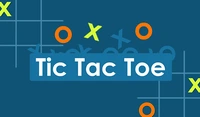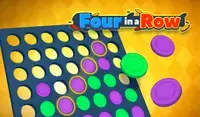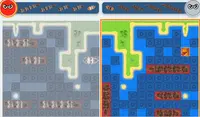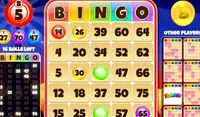Sorry... this game is not playable in your browser.


This Flash game is currently not playable in your browser, but we're working on a fix! Come back regularly to see if it's ready to play.
Most browsers no longer support Flash. Affected games are indicated by





Ludo
Game content reviewed byJonathan Keefer
Ludo Instructions
In Ludo, your goal is to get all four of your checker pieces around the board and back to your home color. In this version, you may play against 3 other computers, or a mix of computers and friends.
Once the game begins, players take turns rolling their die. You must first roll a six to move a piece out of your starting box. When you have only one piece to move, your freed piece will move automatically. From here on out, every six you roll will allow you to either move a new piece onto the board, or move one already on the board. You'll also get a free roll after rolling a six. Once you have multiple pieces on the board, you may choose which piece to move after rolling the die.
Your piece is safe once it lands in the center of the arrow. Land on an opponent's piece to knock it back to start and get another free roll. The starred and colored tiles are all safe spaces. Try to keep your pieces on them to avoid getting knocked back by your opponents!
LUDO TIPS & TRICKS
While Ludo is largely luck-based, there are definitely a few strategic decisions that players need to make. Read on to learn about some Ludo tips and tricks.
Choose wisely
After that first piece is moved out of your starting box, each six you roll will come with a choice: add another piece to the board, or move one of your current pieces forward. In general, it’s best to move your pieces onto the board. Freeing all your pieces will give you more choices when it is your turn to move.
Keep your distance
The maximum amount of spaces any piece can move is six, unless that player rolls a six and gets another roll. Maintaining a distance of seven or more spaces between your piece and any opponents' pieces behind you can help you avoid getting knocked back to start.
Keep your pieces safe
There are some spots on the board where your piece will be protected from being sent back home. If you have more than one piece on the board, try to keep at as many of them as possible on a colored or star space. This way one piece travels the board while the others are kept in reserve. If all of your pieces are currently safe, move pieces that don't have opposing pieces right behind them.
Take two turns
A good strategy is to take advantage of your free rolls. You’ll get a free turn after you either roll a six, land a piece in the goal, or knock an opposing piece off the board.
Think before you move
To fully take advantage of those free turns, you’ll have to plan a bit, especially if you have multiple pieces on the table. When progressing, count the spaces between your pieces and others. If an opponent is two spaces ahead of one of your pieces and you roll a two, move that piece forward. You’ll knock back your opponent AND score a free roll.
In Ludo, your goal is to get all four of your checker pieces around the board and back to your home color. In this version, you may play against 3 other computers, or a mix of computers and friends.
Once the game begins, players take turns rolling their die. You must first roll a six to move a piece out of your starting box. When you have only one piece to move, your freed piece will move automatically. From here on out, every six you roll will allow you to either move a new piece onto the board, or move one already on the board. You'll also get a free roll after rolling a six. Once you have multiple pieces on the board, you may choose which piece to move after rolling the die.
Your piece is safe once it lands in the center of the arrow. Land on an opponent's piece to knock it back to start and get another free roll. The starred and colored tiles are all safe spaces. Try to keep your pieces on them to avoid getting knocked back by your opponents!
Ludo TIPS & TRICKS
While Ludo is largely luck-based, there are definitely a few strategic decisions that players need to make. Read on to learn about some Ludo tips and tricks.
Choose wisely
After that first piece is moved out of your starting box, each six you roll will come with a choice: add another piece to the board, or move one of your current pieces forward. In general, it’s best to move your pieces onto the board. Freeing all your pieces will give you more choices when it is your turn to move.
Keep your distance
The maximum amount of spaces any piece can move is six, unless that player rolls a six and gets another roll. Maintaining a distance of seven or more spaces between your piece and any opponents' pieces behind you can help you avoid getting knocked back to start.
Keep your pieces safe
There are some spots on the board where your piece will be protected from being sent back home. If you have more than one piece on the board, try to keep at as many of them as possible on a colored or star space. This way one piece travels the board while the others are kept in reserve. If all of your pieces are currently safe, move pieces that don't have opposing pieces right behind them.
Take two turns
A good strategy is to take advantage of your free rolls. You’ll get a free turn after you either roll a six, land a piece in the goal, or knock an opposing piece off the board.
Think before you move
To fully take advantage of those free turns, you’ll have to plan a bit, especially if you have multiple pieces on the table. When progressing, count the spaces between your pieces and others. If an opponent is two spaces ahead of one of your pieces and you roll a two, move that piece forward. You’ll knock back your opponent AND score a free roll.
What is Ludo called in America?
The American counterpart to Ludo is called Parcheesi. While they aren’t the exact same, they are both dice-rolling games with similar luck-based gameplay.
Can I play Ludo online?
Just like every other non-flash game on Coolmath Games, you can play Ludo online for free. The Coolmath Games version runs on HTML5, so players can play Ludo without having to download anything.
Are Ludo and Parcheesi the same thing?
Ludo and Parcheesi both stemmed from the ancient Indian game, Pachisi. There are two main differences between Ludo and Parcheesi: The dice and the map.
- Ludo only has one die, whereas Parcheesi has two. This means that lower numbers tend to be rolled in Ludo.
- Parchisi has a map that is much more similar to the traditional Pachisi game map. It is a more linear and simple shape. On the other hand, Ludo has a more intricate square design with arrows leading to the center of the map.
What are some similar games to Ludo Online?
We have quite a few classic games on the site that you may enjoy if you like Ludo. Whether it is a card game or a wheel-spinning game, we have got you covered.
Solitaire is one of the all-time classic games on our site. Part of the reason that people love it so much is that it combines skill and luck, which results in a game where really anything can happen. This is similar to Ludo. You will have to make good decisions, but luck must also be on your side if you are hoping to win.
Push Your Luck is another great game that you will need luck and skill for. In Push Your Luck, players must spin a wheel and guess if it will land on a higher or lower number. This is a great game to learn about risk and probability.
Is Ludo a game of luck or skill?
While there certainly is some strategy and skill involved in Ludo, it is largely a luck-based game. This is because players are heavily impacted by which dice roll they get, which is completely random.
For example, it can take players 10 turns to get their first piece out of their home base. On the other hand, players can also roll a 6 right at the beginning and be given a massive advantage. It all comes down to the fate of the dice.
How to play Ludo on your phone
Did you know you can also play Ludo on your phone? It’s a great way to play without worrying about losing your save data.
For iOS devices, simply tap the "Share" icon ![]() in Safari and select "Add to Home Screen". For Android devices, tap the “Menu” icon
in Safari and select "Add to Home Screen". For Android devices, tap the “Menu” icon ![]() and select "Install App".
and select "Install App".
Just a moment while your advertisement loads
Advertisement
Just a moment while your advertisement loads
Advertisement
Ludo
Game content reviewed byJonathan Keefer
Ludo Instructions
In Ludo, your goal is to get all four of your checker pieces around the board and back to your home color. In this version, you may play against 3 other computers, or a mix of computers and friends.
Once the game begins, players take turns rolling their die. You must first roll a six to move a piece out of your starting box. When you have only one piece to move, your freed piece will move automatically. From here on out, every six you roll will allow you to either move a new piece onto the board, or move one already on the board. You'll also get a free roll after rolling a six. Once you have multiple pieces on the board, you may choose which piece to move after rolling the die.
Your piece is safe once it lands in the center of the arrow. Land on an opponent's piece to knock it back to start and get another free roll. The starred and colored tiles are all safe spaces. Try to keep your pieces on them to avoid getting knocked back by your opponents!
LUDO TIPS & TRICKS
While Ludo is largely luck-based, there are definitely a few strategic decisions that players need to make. Read on to learn about some Ludo tips and tricks.
Choose wisely
After that first piece is moved out of your starting box, each six you roll will come with a choice: add another piece to the board, or move one of your current pieces forward. In general, it’s best to move your pieces onto the board. Freeing all your pieces will give you more choices when it is your turn to move.
Keep your distance
The maximum amount of spaces any piece can move is six, unless that player rolls a six and gets another roll. Maintaining a distance of seven or more spaces between your piece and any opponents' pieces behind you can help you avoid getting knocked back to start.
Keep your pieces safe
There are some spots on the board where your piece will be protected from being sent back home. If you have more than one piece on the board, try to keep at as many of them as possible on a colored or star space. This way one piece travels the board while the others are kept in reserve. If all of your pieces are currently safe, move pieces that don't have opposing pieces right behind them.
Take two turns
A good strategy is to take advantage of your free rolls. You’ll get a free turn after you either roll a six, land a piece in the goal, or knock an opposing piece off the board.
Think before you move
To fully take advantage of those free turns, you’ll have to plan a bit, especially if you have multiple pieces on the table. When progressing, count the spaces between your pieces and others. If an opponent is two spaces ahead of one of your pieces and you roll a two, move that piece forward. You’ll knock back your opponent AND score a free roll.
What is Ludo called in America?
The American counterpart to Ludo is called Parcheesi. While they aren’t the exact same, they are both dice-rolling games with similar luck-based gameplay.
Can I play Ludo online?
Just like every other non-flash game on Coolmath Games, you can play Ludo online for free. The Coolmath Games version runs on HTML5, so players can play Ludo without having to download anything.
Are Ludo and Parcheesi the same thing?
Ludo and Parcheesi both stemmed from the ancient Indian game, Pachisi. There are two main differences between Ludo and Parcheesi: The dice and the map.
- Ludo only has one die, whereas Parcheesi has two. This means that lower numbers tend to be rolled in Ludo.
- Parchisi has a map that is much more similar to the traditional Pachisi game map. It is a more linear and simple shape. On the other hand, Ludo has a more intricate square design with arrows leading to the center of the map.
What are some similar games to Ludo Online?
We have quite a few classic games on the site that you may enjoy if you like Ludo. Whether it is a card game or a wheel-spinning game, we have got you covered.
Solitaire is one of the all-time classic games on our site. Part of the reason that people love it so much is that it combines skill and luck, which results in a game where really anything can happen. This is similar to Ludo. You will have to make good decisions, but luck must also be on your side if you are hoping to win.
Push Your Luck is another great game that you will need luck and skill for. In Push Your Luck, players must spin a wheel and guess if it will land on a higher or lower number. This is a great game to learn about risk and probability.
Is Ludo a game of luck or skill?
While there certainly is some strategy and skill involved in Ludo, it is largely a luck-based game. This is because players are heavily impacted by which dice roll they get, which is completely random.
For example, it can take players 10 turns to get their first piece out of their home base. On the other hand, players can also roll a 6 right at the beginning and be given a massive advantage. It all comes down to the fate of the dice.
How to play Ludo on your phone
To play Ludo easily any time, you can add it directly to your phone as an app. It’s a great way to play without worrying about losing your game save data.
For iOS devices, simply tap the "Share" icon ![]() in Safari and select "Add to Home Screen". For Android devices, tap the “Menu” icon
in Safari and select "Add to Home Screen". For Android devices, tap the “Menu” icon ![]() and select "Install App".
and select "Install App".
In Ludo, your goal is to get all four of your checker pieces around the board and back to your home color. In this version, you may play against 3 other computers, or a mix of computers and friends.
Once the game begins, players take turns rolling their die. You must first roll a six to move a piece out of your starting box. When you have only one piece to move, your freed piece will move automatically. From here on out, every six you roll will allow you to either move a new piece onto the board, or move one already on the board. You'll also get a free roll after rolling a six. Once you have multiple pieces on the board, you may choose which piece to move after rolling the die.
Your piece is safe once it lands in the center of the arrow. Land on an opponent's piece to knock it back to start and get another free roll. The starred and colored tiles are all safe spaces. Try to keep your pieces on them to avoid getting knocked back by your opponents!
Ludo TIPS & TRICKS
While Ludo is largely luck-based, there are definitely a few strategic decisions that players need to make. Read on to learn about some Ludo tips and tricks.
Choose wisely
After that first piece is moved out of your starting box, each six you roll will come with a choice: add another piece to the board, or move one of your current pieces forward. In general, it’s best to move your pieces onto the board. Freeing all your pieces will give you more choices when it is your turn to move.
Keep your distance
The maximum amount of spaces any piece can move is six, unless that player rolls a six and gets another roll. Maintaining a distance of seven or more spaces between your piece and any opponents' pieces behind you can help you avoid getting knocked back to start.
Keep your pieces safe
There are some spots on the board where your piece will be protected from being sent back home. If you have more than one piece on the board, try to keep at as many of them as possible on a colored or star space. This way one piece travels the board while the others are kept in reserve. If all of your pieces are currently safe, move pieces that don't have opposing pieces right behind them.
Take two turns
A good strategy is to take advantage of your free rolls. You’ll get a free turn after you either roll a six, land a piece in the goal, or knock an opposing piece off the board.
Think before you move
To fully take advantage of those free turns, you’ll have to plan a bit, especially if you have multiple pieces on the table. When progressing, count the spaces between your pieces and others. If an opponent is two spaces ahead of one of your pieces and you roll a two, move that piece forward. You’ll knock back your opponent AND score a free roll.
Votes












